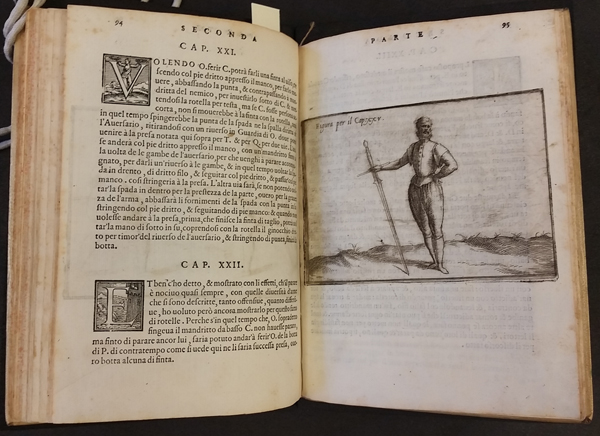
Trattato di scienza d' arme: et un dialogo in detta materia, Camillo Agrippa, 1568. U860 .A27 1568 *
Agrippa was interested in how mathematics and astronomy played a role in the perfection of human movement. This Venetian second edition employs full-page spreads of bodies in motion.

Trattato di scienza d' arme: et un dialogo in detta materia, Camillo Agrippa, 1568. U860 .A27 1568 *
Here, a Venetian gentleman brandishing a German-style longsword looks back at the reader, while elaborate Italianate font in the style of Arrighi graces the page with beautiful ornamentation, and intricate capital letters.

Trattato di scienza d' arme: et un dialogo in detta materia, Camillo Agrippa, 1568. U860 .A27 1568 *
Typical of 16th century Venetian book production, creative uses of layout were employed to a harmonious and stunning effect.
Trattato di scienza d' arme: et un dialogo in detta materia, Camillo Agrippa, 1568.
An excellent example of an early fencing manual, Camillo Agrippa's Trattato di scienza d'arme (Treatise on the Science of Arms), located at the William Andrews Clark Memorial Library, it is a second edition that was published in Venice in 1568. This version differs from the first edition published in Rome, with the addition of engravings that occupy a full-spread of two pages at a time. Agrippa, in a true Humanist fashion was himself an expert in many fields; he was a renaissance fencing master, architect, mathematician, as well as an engineer, and melded the concepts of all of his scholarly interests in this amazing treatise.1
Presented as a philosophical dialogue, this work by Agrippa presents the idea that his system of fencing could be taught by rationalizing each movement through the means of geometry.2 Fueled by Renaissance Humanism and ideas rooted in Neo-Platonism, the beginnings of the early modern era in the 16th century began to see a rationalization of the world through a lens of natural and cosmological observational practices. This unison of melding the study of the human body and that of astronomy as both a microcosm and a macrocosm was typical of Aristotelian thought that had dominated the western scientific world before the arrival of materialism in the later 17th and 18th centuries. In a similar fashion to Baldessare Castiglione's il Cortegiano, Agrippa's Treatise was born out of a culture firmly rooted in the aristocratic courts of the renaissance, where fencing was a standard practice in the education of young noblemen.3
This book, in addition to the more well-known manual written by Capo Ferro, is still studied and utilized by European martial arts enthusiasts, fencing athletes, and stage combat choreographers.4
This copy is bound in vellum, and contains marginalia bearing the signature of its owner, in addition to stamps of heraldry on the recto and verso sides of the frontispiece.
Notes
1 Mondschein, Ken. "The Number of Motion: Camillo Agrippa's Geometrical Fencing and the Enumeration of the Body." Journal of the Northern Renaissance, no. 6 (2014).Found here, at the Journal of the Northern Renaissance Online ↩
2 Ibid.↩
3Burke, Peter. The Fortunes of the Courtier: The European Reception of Castigliones Cortegiano. Cambridge, UK: Polity Press, 2007. .↩
4Kirby, Jared. Italian rapier combat : Ridolfo Capo Ferro London: Greenhill, 2004. .↩
This spotlight exhibit by Tanya Yvette Knipprath as part of Dr. Johanna Drucker's "History of the Book and Literacy Technologies" seminar in Winter 2018 in the Information Studies Department at UCLA.
For documentation on this project, personnel, technical information, see Documentation. For contact email: drucker AT gseis.ucla.edu.